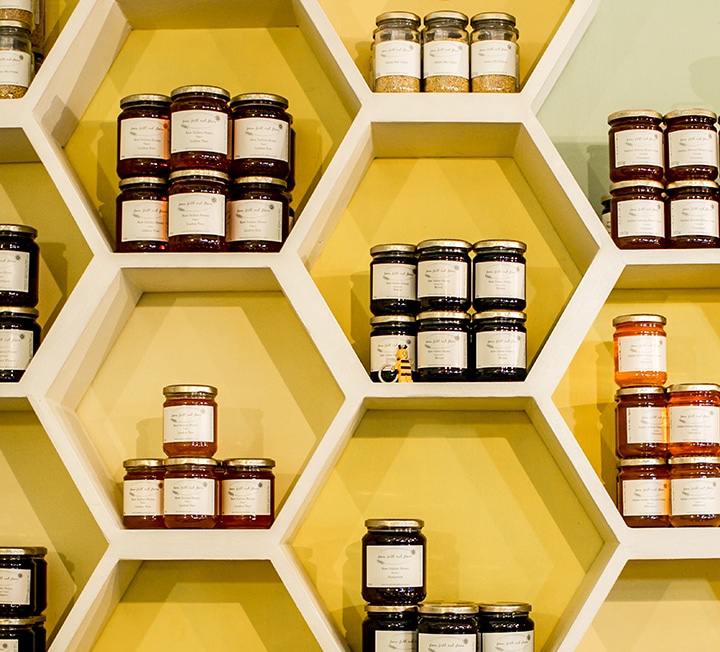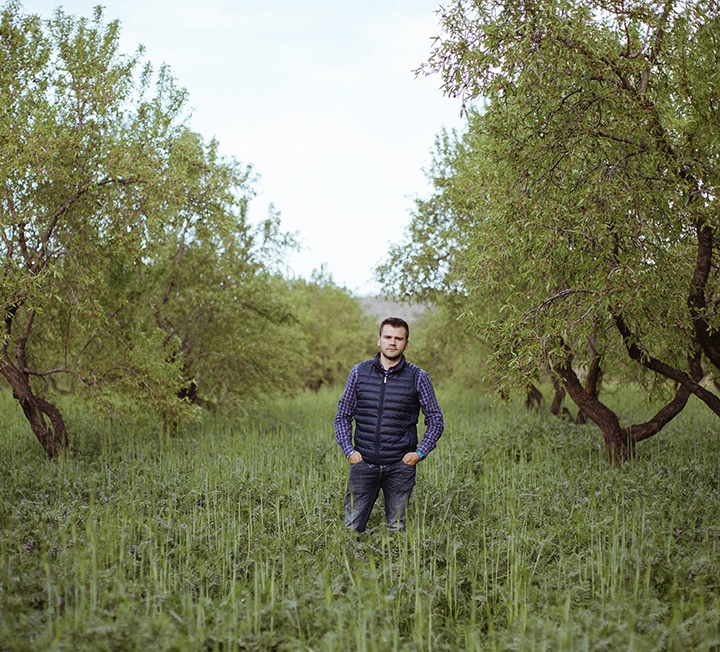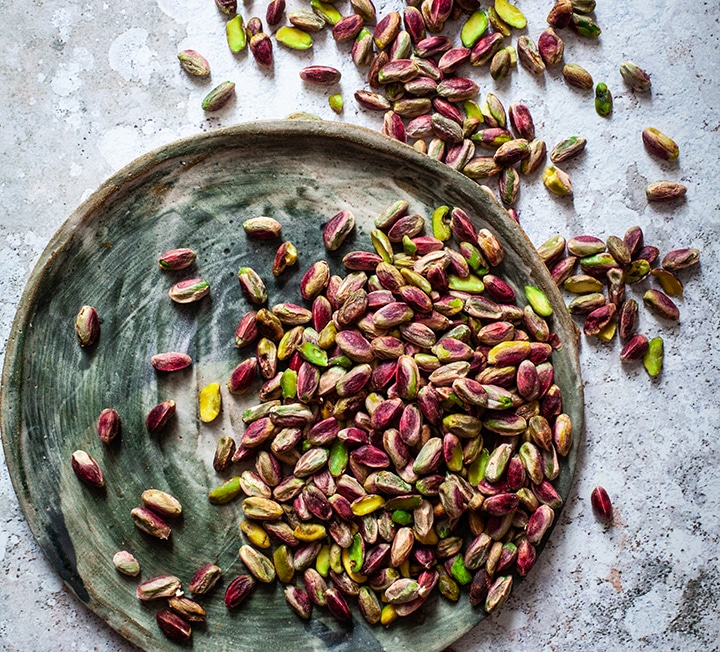Hive mind
The best honey, like the best wine, offers a clear expression of the place that produces it. To understand how., we headed to an apiary on the Swedish coast, source of one of the remarkable honeys sold by From Field and Flower
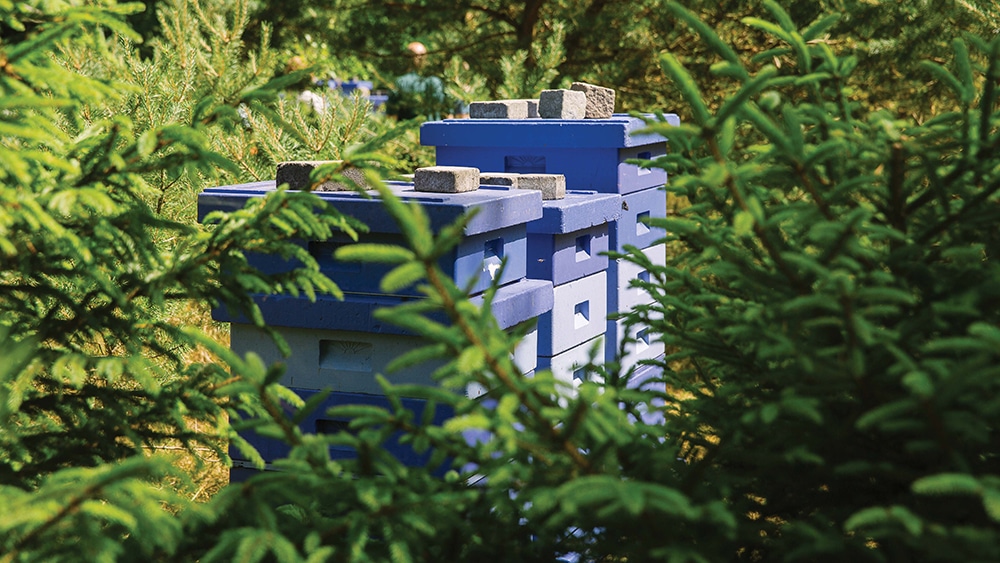

“DIFFERENT FLOWERS YIELD DIFFERENT HONEYS; INDIVIDUAL APIARIES ARE UNIQUE, JUST AS SINGLE VINEYARDS ARE”
Words: Clare Finney / Images: Joseph Fox
“We have one nation to thank for having a language relating to honey tasting, and that’s Italy,” says Viktoria Bassani warmly, looking admiringly toward Stefano. The Piedmontese co-founder of From Field and Flower smiles back proudly. Though he did not of course invent this honey lexicon, in spearheading the sale of honey varietals at one of Europe’s biggest food markets, he has certainly contributed to his country’s sweet and golden legacy. The pale, shimmering ‘pearl’ honey that Viktoria produces is just one example of the many highly distinctive and wildly diverse honeys from around the world sold at the stall in Borough Market.
That’s why we’re here: honey – like wine, coffee or cheese – is at its best an expression of the land and the people that produce it, varying dramatically not just between landscapes or regions, but between each collection of beehives. And Viktoria is one of the most passionate proponents of varietal honey to be found this side of the Alps.
Viktoria has 80 hives, divided between many different apiaries around Malmo, Sweden – which is where we meet before travelling onto an apiary of hers near the coast. Her daughter, Isabel, joins us. Though Viktoria is the pioneer who researched, built and founded the bee business, in recent years it’s become a real family affair. Throughout long school and university holidays, Isabel has helped her mother extract, jar and label the honey from each apiary. Marcus, her teenage son, is responsible for the website, from which Viktoria sells her honey to Sweden and beyond – including, surprisingly, Qatar. “There is a real appreciation of honey over there,” she explains to our bemused faces. “They love it a lot, and it’s hard to come by.”

It’s testament to Viktoria’s ethics that she initially refused this lucrative opportunity on environmental grounds. “When I first started getting requests I said, ‘Is there no honey produced in Qatar?’ They told me it was almost impossible to produce, because it is mostly desert.” Eventually Viktoria conceded, providing it was shipped rather than flown, to reduce the carbon footprint. “It takes longer, but you know – honey can last for millennia,” she smiles. This claim was put to the test by archaeologists excavating the Egyptian pyramids, who found pots of honey that were still edible 4,000 years on, thanks to its high sugar content.
Of course, we’ve refined our craft since then, with purpose-built hives, extractors and, at the extreme end, industrial production. But the bees still do the bulk of the work. “That is what I get excited about,” says Viktoria. “The bees have perfected their methods over thousands of years. I just have to tune in and listen to what they are doing.”
Tune in she does – almost literally, when you consider that the ‘buzzing’ of bees is the sound of them evaporating the water in the nectar they’ve collected by vibrating their wings. “At 20 per cent or less, it’s honey,” says Viktoria. The process is difficult to understand without lifting the lid on a beehive and taking a detailed look at the world therein: the tessellated web of honeycomb, the worker bees bringing nectar, and the constant, mesmeric humming of thousands of working wings and bodies. “I think it’s a lovely sound,” says Viktoria, pointing to a honeycomb cell that has just recently had a filmy wax ‘cap’ layered on top of it – a signal to the beekeeper that the frame is ready to take away. “Once they have started to cap the honeycomb, that means the bees know it is honey, and stable for the next thousand years.”
We huddle closer, mindful of the new-born bees that pose the only real risk to humans opening a bee hive. “They cannot fly for 10 days after birth, so if they fall out of the hive when we open it they want to crawl back in again.” If they’re unlucky, they’ll crawl up your leg by mistake; if they’re really unlucky, you’ll move so sharply they’ll be prompted to sting you. “They do try to avoid stinging if possible – because if they sting you, it kills them,” says Viktoria, semi-reassuringly. Fortunately, the heavy bee suits and wellington boots we’re wearing will protect us from everything except the heat – as searing in Sweden this summer as it was back home – and the wild boars.
The wild boars are a recent development. Viktoria has yet to see them, but has been informed of their presence by a farmer who hosts some of her apiaries. It could be worse – the repopulation of bears in the north of the country has created a growing problem for some of Viktoria’s peers, forced to fend off aspiring (and considerably more aggressive) Winnie the Poohs. The heatwave is also new. It’s a heady 26C and it’s been like this for two months without pause. “It’s unheard of here,” she says disbelievingly. While Viktoria is worried about the lack of rainfall, the high temperatures are a boon for both the quantity and flavour of her honey.
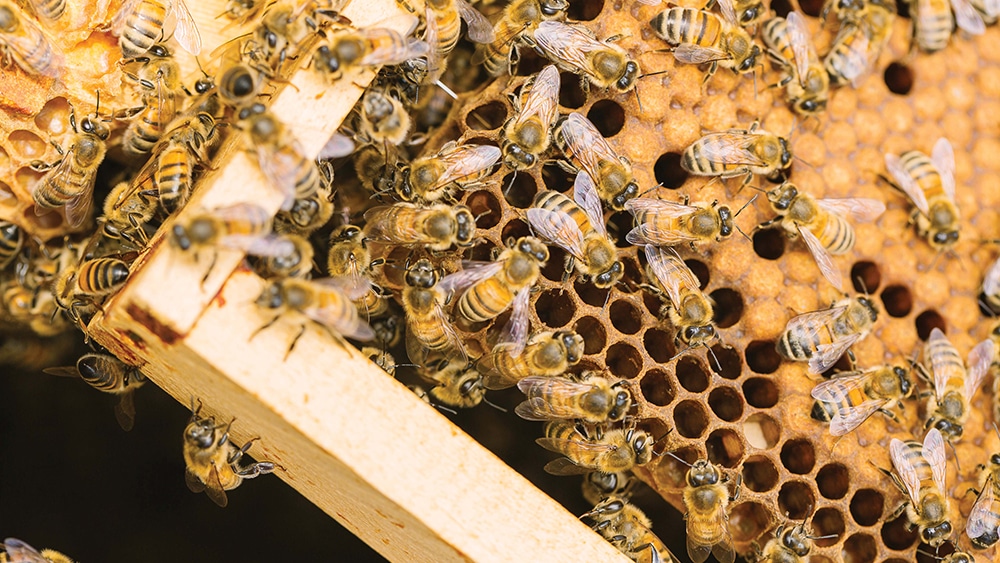
“We have already collected far more than we would in a normal season – and it’s mid-July,” she says, wonderingly. “A normal season lasts to the end of September.” The hives are big, unusually so, and the honey uncharacteristically flavourful. “Usually in this part of the world the early season honey hasn’t had enough time to develop rich flavours. It’s deliciously aromatic,” she continues, “but it is often quite neutral.” She likens it to growing strawberries: “The longer they are on the vine, the more flavour they will develop. They don’t taste as strong if they develop quickly. Likewise with honey: we get more intensely flavoured honey at the end of the season.”
Though produced early on, the pearl honey is delicious, interjects Sam Wallace, From Field and Flower co-founder and Stefano’s partner in life and business. “It’s the first one we encourage new visitors to the stall to taste, because it is so delicate.” Still, she’s as eager as any of us to try some of 2018’s heady ‘heatwave’ honey.
Viktoria isn’t collecting today. Ours, she says, is more of a “social visit”, allowing her to check in with her bees and offer me, Sam and Stefano a behind-the-scenes glimpse of the bee industry. The colour of the hive strikes us first: a bright lavender blue which seems both out of place and yet curiously at home, dappled with morning sunshine in the pine forest clearing. “The bees prefer blue and purple flowers, so I thought, why not adopt blue for the hive? I like blue,” she laughs. Less obvious to the eye are the hive’s environmental credentials. “These will last for 35 years, so they’re the most sustainable option, and using plastic frames inside rather than timber allows us to recycle the bees’ wax for them.” Just how this works will become clear later.
These bees are busy. This one apiary has produced more honey this season than Viktoria’s whole collection did last year – and shows no signs of stopping when we visit. Each tray is laced with honeycombs, which the house bees are busy either filling with nectar or capping with wax. “Foraging bees come back with their load in what we call the ‘honey balloon’,” says Viktoria, “and they want to get rid of it so they can fetch more. They dump it onto the house bee, who brings it to the right cell and starts reducing the water content.” Knowing what we know now, the background buzz suddenly seems less of a lazy hum, more the sound of richly purposeful energy.
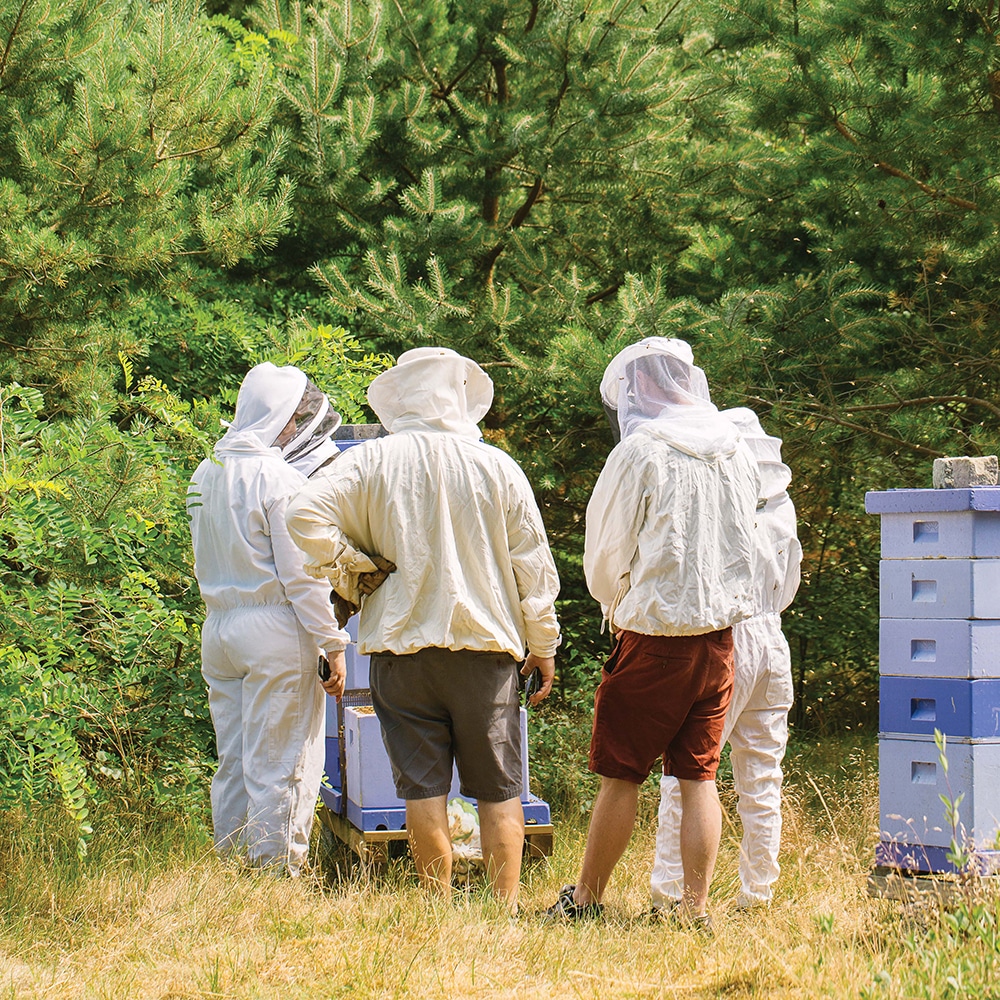
“At this time of year, it will be heather honey. A lot grows on the beach nearby – the sea is only 200 metres away,” she continues. Maybe it’s her astute palate, having worked as a sensory wine analyst before swapping vineyards for apiaries, but Viktoria maintains she could recognise the apiary’s honey blind, on account of its subtly salty taste. “My colleagues call it ‘beeroir’ – like terroir for wines,” she laughs. “I’m not sure it works as a word – the English will think it’s to do with beer and be very confused. But we do need to start talking about the way honey is affected by microclimate and geography.”
Texture. Colour. Viscosity. Scent. All this before even tasting the honey, which can be as varied as wine in its flavour profile and mouthfeel. “When I first started, all I could think is, it’s sweet. I couldn’t possibly understand how I could taste anything beyond that,” Viktoria recalls. Even her extensive experience in the wine industry could not help her when it came to writing tasting notes for honeys. She looked to Italy, where researchers had developed a colour chart, connecting flavours and shades to nectar sources. In Bologna, three postgraduate students had written a paper on honey varietals. She read it avidly, together with a seminal book by Eva Crane, an English beekeeper and mathematician. “Dr Crane passed away in 2007, just when I started, but I knew by then that I wanted to focus on varietals – to bring the variety of flowers in nature into the jar.”
For many people – or at least, those who don’t yet frequent From Field and Flower – the concept of honey varietals is still an unfamiliar one. All the honey you see in the supermarket will have been blended, with the bigger companies blending honeys from hundreds of apiaries across Europe. These honeys are pasteurised: heated up to create a cohesive texture, and to eradicate any variations in taste. “The main thing is to create a consistent, low cost product,” explains Sam. “Any beneficial bacteria will be killed off by the heat – and you certainly won’t taste any variation.” That’s fine if you just want straight-up sweetness to cook with, say, but it’s of little interest to someone as steeped in the concept of terroir as Viktoria.
Different flowers yield different honeys just as different grapes yield different wines; individual apiaries are unique, just as single vineyards are. Their ‘beeroir’ cannot be replicated by an apiary 20km away, or even by the same apiary the following year. “Every season is a novelty to me,” beams Viktoria. Come harvest time, the honey is extracted, jarred and labelled to reflect its time and place. Viktoria extracts the honey from the frames with as little mechanical intervention as possible. “With experience I’ve found it affects the flavour slightly, and I don’t want to produce bland honey. We have 80 hives and that is the way I like it to be.”
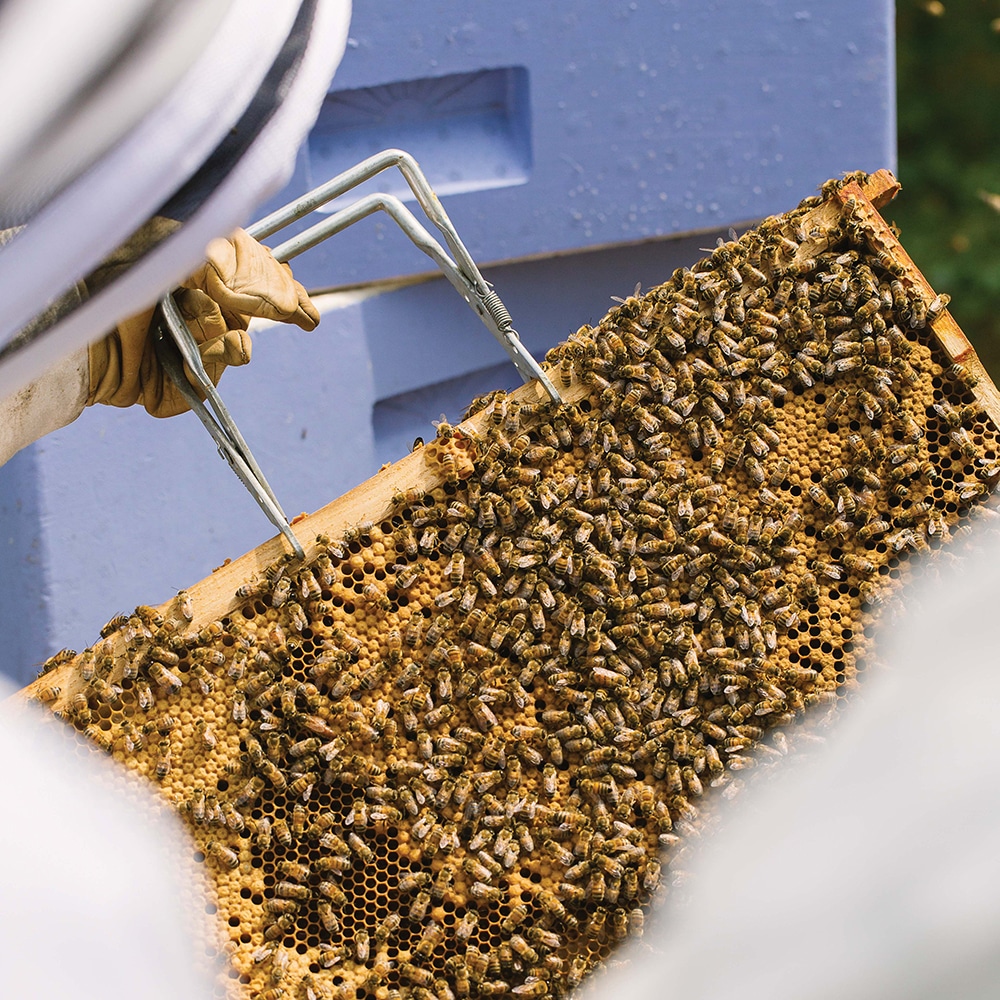
Carefully, Viktoria closes up the hive. Some casualties are inevitable: “I cannot possibly stand here all day waiting for them all to move away from the edge, though I do try to shift as many as possible.” The bees themselves “don’t even think about it. They treat the hive as one organism, one body,” she continues – making it all the more remarkable that they know Viktoria by scent and, according to research just published in Germany, by sight. “The average bee lives for four to six weeks. It is like an inherited knowledge,” she marvels, as she calmly replaces the final frame and puts the lid on it. We make our way back to the trucks, peeling off the white, linen layers as we walk, and set off toward the processing unit next to Viktoria’s house in the countryside.
“It’s quite old fashioned,” she grins as, in food hygiene gear complete with clogs, we step into her shed-come-honey plant. On one side, honey frames are stacked ready for extraction. Next to that, stripped honeycombs lie seemingly abandoned in a sticky, craggy mound. The extractor sits in front of us. “She’s called Francesca because she’s from Italy, and she does things the way she wants to do them. Not the way we want,” Viktoria laughs, turning the machine onto its lowest setting. Francesca’s stainless-steel tummy rumbles as the centrifuge spins slowly, with the honey-filled frames attached to the central structure. “It’s very simple. They spin around, the honey hurtles out of the wax onto the walls, slides down to where this tap is and comes out.”
Viktoria stops Francesca, opens up a tap near the extractor’s feet, and smiles as we exclaim at the heavy stream of gold pouring smoothly out of it. “Again, again!” we cry, when the honey eventually slows to a trickle. Viktoria happily obliges, sending Francesca into another gentle spin. “There is lime tree honey in here. Can you smell it?” she says – and sure enough, when she opens the tap a distinct citrus scent hangs in the air. This variety is not for blending. Come tomorrow, it will be put into jars – unfiltered, because “removing those trace bits of pollen removes so much flavour” – and labelled with today’s date and the location of the apiary from whence it came.
The now-empty honeycombs, meanwhile, will be melted down for their wax. “I prefer the look and feel of timber frames, but the plastic offers a closed circuit,” Viktoria tells us. “We don’t have to send our wax away. We just melt it down overnight, roll it onto plastic frames to go back in the hive, and the bees can reuse it.” They can of course produce more wax from their glands, “but it’s hard work for the them. To make one kilo of wax they need to consume nine kilos of honey.”
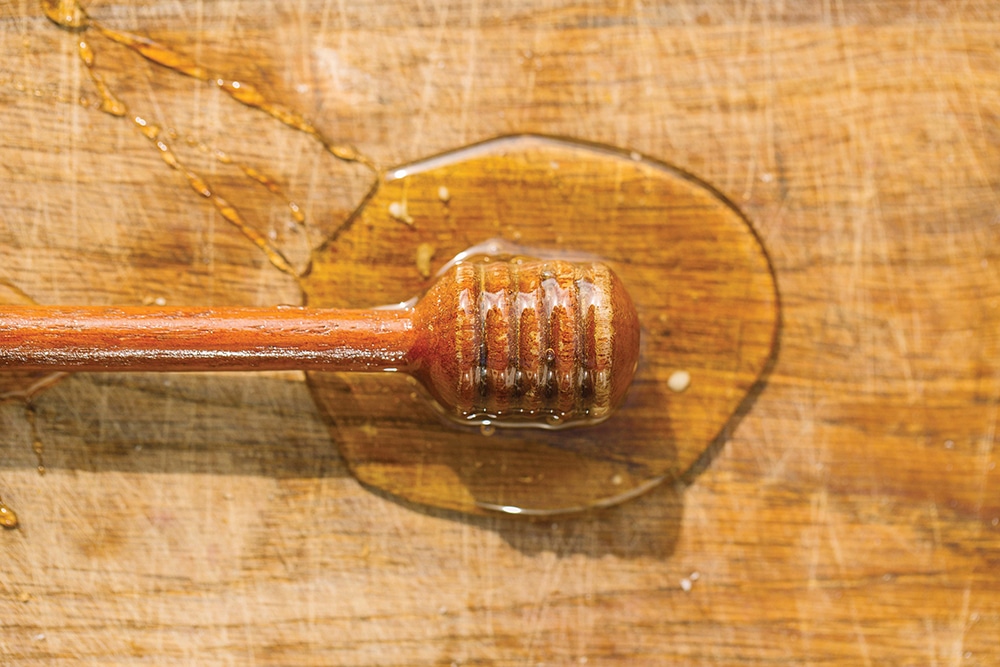
She’s waiting for a cool night. We all are at this point in the summer, but it particularly matters for Viktoria in order for the wax to set on the frames, and for the creation of the pearl honey sold by From Field and Flower – an opaque, thick-set honey, the creaminess of which results from painstakingly stirring, for around 10 hours over the course of six or seven days. “For stirring, we need the honey to be at the perfect temperature. If it’s above 25C we have to halt the operation,” she says, “and that has been a challenge this year!”
They even contemplated stirring at night, “but no one wanted to do that,” smiles Viktoria. Later on, she shows us a basin of half-creamed honey, its contents ivory-white and steeped in scent. They stir by hand: too vigorous a stir would release the delicate aroma compounds. Unlike her other honeys, the pearl honey does have to be filtered for stray bits of pollen whose presence would prevent its transformation from liquid gold to dense, sweet cream. The creaming of honey to prevent it from crystallising is an old Scandinavian tradition, but Viktoria has over the past 12 years elevated the technique to new heights, resulting in the gloriously smooth product that she calls ‘pärlehonung’.
We taste it in the garden, alongside various other honeys from her apiaries in the centre of Malmo (“bees thrive in the city – they get such variety in the parks”), on organic farms, and of course from the one we visited. Last year’s pearl honey is velvety and delicate; the lime honey we saw coming out of Francesca is almost leaping with flavour; the urban honeys are as multi-faceted and complex as the environment that yielded them; and the dark, jammy heather honey is brooding and almost bitter-sweet. Their differences go beyond language – or at least, they go beyond my language. I am no more qualified to talk in detail about these honeys than I am to intrude upon a conversation between Swedes or Italians. I can taste them though – and I can, now I have seen it up close, appreciate the hard work both bees and beekeeper put into preserving these snapshots of nature’s inimitable, infinite variety.
